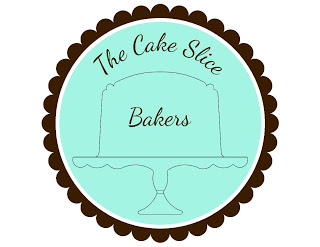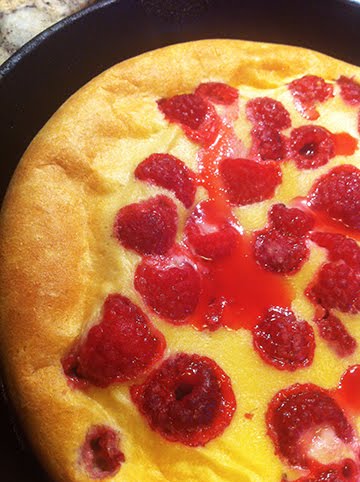 Well, if you really want it, I guess I could give you half. It’s hard to share the last of something this delicious.
Well, if you really want it, I guess I could give you half. It’s hard to share the last of something this delicious.Bagels are a classic food. “The bagel, in its peripatetic history, has moved from the shtetls of Eastern Europe to the delis of the United States” says Carolina Rodriguez while introducing this recipe from a friend of hers.
For the Daring Baker’s June Challenge, we are making Real Honest Jewish Purist’s Bagels. The recipe is from Johanne Blank and is found at jewish-food.org. Since it is a purist’s version, it involves yeasted dough that, after a first rising, shaping, and second rising, is boiled, then baked. The result is a densely textured donut shaped piece of bread with a nice chewy bite and yeasty flavor. It is perfect just sliced in half and toasted, then slathered with butter or cream cheese.

Often the bagels are sprinkled before baking with seeds like poppy seeds or sesame seeds, or with sea salt or onions. I chose to go with sesame seeds and sea salt, with one left plain to see how that was. They were all tasty.

For lots of other, imaginative variations, check out the other Daring Bakers blogs. Thanks go to Jenny and Freya for choosing such a delicious challenge.
There is little that is difficult about this recipe. If the yeast proofs then it’s just a matter of stirring in the flour until a stiff dough forms. I used the full amount of flour called for, plus a little extra when I did the shaping. I used all-purpose unbleached bread flour, not regular flour. Since bagels are bread, it makes sense, doesn't it?
The yeast does the work during the two risings and also during the boiling and baking. The part that allows for some creativity is how you shape the bagel. Since it is a donut shape, you can poke a hole up through the middle of the dough and then work the dough out from the hole, or you can roll the piece of dough into a snake and then put the ends together, leaving a hole in the middle. I tried both. In the end I couldn’t really tell which method I had use for any particular bagel.
 What surprised me was how puffy the bagels got while boiling. None of mind sank first as the recipe said they would, but the final result was dense and chewy bagels, so I guess its O.K.
What surprised me was how puffy the bagels got while boiling. None of mind sank first as the recipe said they would, but the final result was dense and chewy bagels, so I guess its O.K.This is kind of a fun recipe because you can mix the dough with your hand and then use your hands to knead the dough,
 then for the shaping. Working with yeast dough always feels good…it’s elastic and you can almost feel the little yeasties growing in the dough. You don’t let out as much aggression as you would from beating a butter block with a rolling pin as was done last month to make puff pastry, but kneading dough is very soothing and somehow contemplative.
then for the shaping. Working with yeast dough always feels good…it’s elastic and you can almost feel the little yeasties growing in the dough. You don’t let out as much aggression as you would from beating a butter block with a rolling pin as was done last month to make puff pastry, but kneading dough is very soothing and somehow contemplative.This recipe below makes at least 15 bagels, but you can make half a batch. I did and now I wish that I had made the full recipe. These bagels are head and shoulders above anything you might buy at the supermarket. Try it…you’ll see.
Real Honest Jewish Purist's Bagels
Daring Bakers Challenge #7: June 2007
Hosts: Jenny (All Things Edible) and Freya (Writing at the Kitchen Table)
Recipe Quantity: Fifteen (15) large, plain, Kosher bagels
Ingredients:
6-8 cups bread (high-gluten) flour
4 tablespoons dry baking yeast
6 tablespoons granulated white sugar or light honey (clover honey is good)
2 teaspoons salt
3 cups hot water
a bit of vegetable oil
1 gallon water
3-5 tablespoons malt syrup or sugar
a few handfuls of cornmeal
Equipment:
large mixing bowl
wire whisk
measuring cups and spoons
wooden mixing spoon
butter knife or baker's dough blade
clean, dry surface for kneading
3 clean, dry kitchen towels
warm, but not hot, place to set dough to rise
large stockpot
slotted spoon
2 baking sheets
How You Do It:
Step 1- Proof Yeast: Pour three cups of hot water into the mixing bowl. The water should be hot, but not so hot that you can't bear to put your fingers in it for several seconds at a time. Add the sugar or honey and stir it with your fingers (a good way to make sure the water is not too hot) or with a wire whisk to dissolve. Sprinkle the yeast over the surface of the water, and stir to dissolve.
Wait about ten minutes for the yeast to begin to revive and grow. Skipping this step could result in your trying to make bagels with dead yeast, which results in bagels so hard and potentially dangerous that they are banned under the terms of the Geneva Convention. You will know that the yeast is okay if it begins to foam and exude a sweetish, slightly beery smell.
Step 2- Make Dough: At this point, add about three cups of flour as well as the 2 tsp of salt to the water and yeast and begin mixing it in. Some people subscribe to the theory that it is easier to tell what's going on with the dough if you use your hands rather than a spoon to mix things into the dough, but others prefer the less physically direct spoon. As an advocate of the bare-knuckles school of baking, I proffer the following advice: clip your fingernails, take off your rings and wristwatch, and wash your hands thoroughly to the elbows, like a surgeon. Then you may dive into the dough with impunity. I generally use my right hand to mix, so that my left is free to add flour and other ingredients and to hold the bowl steady. Left-handed people might find that the reverse works better for them. Having one hand clean and free to perform various tasks works best.
When you have incorporated the first three cups of lour, the dough should begin to become thick-ish. Add more flour, a half-cup or so at a time, and mix each addition thoroughly before adding more flour. As the dough gets thicker, add less and less flour at a time.
Step 3- Knead Dough: Soon you will begin to knead it by hand (if you're using your hands to mix the dough in the first place, this segue is hardly noticeable). If you have a big enough and shallow enough bowl, use it as the kneading bowl, otherwise use that clean, dry, flat counter top or tabletop mentioned in the "Equipment" list above. Sprinkle your work surface or bowl with a handful of flour, put your dough on top, and start kneading. Add bits of flour if necessary to keep the dough from sticking (to your hands, to the bowl or counter top, etc....). Soon you should have a nice stiff dough. It will be quite elastic, but heavy and stiffer than a normal bread dough. Do not make it too dry, however... it should still give easily and stretch easily without tearing.
Step 4- Let Dough Rise: Place the dough in a lightly oiled bowl, and cover with one of your clean kitchen towels, dampened somewhat by getting it wet and then wringing it out thoroughly. If you swish the dough around in the bowl, you can get the whole ball of dough covered with a very thin film of oil, which will keep it from drying out.
Place the bowl with the dough in it in a dry, warm (but not hot) place, free from drafts. Allow it to rise until doubled in volume. Some people try to accelerate rising by putting the dough in the oven, where the pilot lights keep the temperature slightly elevated. If it's cold in your kitchen, you can try this, but remember to leave the oven door open or it may become too hot and begin to kill the yeast and cook the dough. An ambient temperature of about 80 degrees Fahrenheit (25 Centigrades) is ideal for rising dough.
Step 5- Prepare Water for Bagels: While the dough is rising, fill your stockpot with about a gallon of water and set it on the fire to boil. When it reaches a boil, add the malt syrup or sugar and reduce the heat so that the water just barely simmers; the surface of the water should hardly move.
Step 6- Form Bagels: Once the dough has risen, turn it onto your work surface, punch it down, and divide immediately into as many hunks as you want to make bagels. For this recipe, you will probably end up with about 15 bagels, so you will divide the dough into 15 roughly even-sized hunks.
Begin forming the bagels. There are two schools of thought on this. One method of bagel formation involves shaping the dough into a rough sphere, then poking a hole through the middle with a finger and then pulling at the dough around the hole to make the bagel. This is the hole-centric method. The dough-centric method involves making a long cylindrical "snake" of dough and wrapping it around your hand into a loop and mashing the ends together. Whatever you like to do is fine. DO NOT, however, give in to the temptation of using a doughnut or cookie cutter to shape your bagels. This will push them out of the realm of Jewish Bagel Authenticity and give them a distinctly Protestant air. The bagels will not be perfectly shaped. They will not be symmetrical. This is normal. This is okay. Enjoy the diversity. Just like snowflakes, no two genuine bagels are exactly alike.
Step 7- Pre-heat Oven: Begin to preheat the oven to 400 degrees Fahrenheit.
Step 8- Half Proof and Boil Bagels: Once the bagels are formed, let them sit for about 10 minutes. They will begin to rise slightly. Ideally, they will rise by about one-fourth volume... a technique called "half-proofing" the dough. At the end of the half-proofing, drop the bagels into the simmering water one by one. You don't want to crowd them, and so there should only be two or three bagels simmering at any given time. The bagels should sink first, then gracefully float to the top of the simmering water. If they float, it's not a big deal, but it does mean that you'll have a somewhat more bready (and less bagely) texture. Let the bagel simmer for about three minutes, then turn them over with a skimmer or a slotted spoon. Simmer another three minutes, and then lift the bagels out of the water and set them on a clean kitchen towel that has been spread on the counter top for this purpose. The bagels should be pretty and shiny, thanks to the malt syrup or sugar in the boiling water.
Step 9- Bake Bagels: Once all the bagels have been boiled, prepare your baking sheets by sprinkling them with cornmeal. Then arrange the bagels on the prepared baking sheets and put them in the oven. Let them bake for about 25 minutes, then remove from the oven, turn them over and put them back in the oven to finish baking for about ten minutes more. This will help to prevent flat-bottomed bagels.
Remove from the oven and cool on wire racks, or on a dry clean towels if you have no racks. Do not attempt to cut them until they are cool... hot bagels slice abominably and you'll end up with a wadded mass of bagel pulp. Don't do it.
How To Customize Outside of Bagels: After boiling but before baking, brush the bagels with a wash made of 1 egg white and 3 tablespoons ice water beaten together. Sprinkle with the topping of your choice: poppy, sesame, or caraway seeds, toasted onion or raw garlic bits, salt or whatever you like. Just remember that bagels are essentially a savory baked good, not a sweet one, and so things like fruit and sweet spices are really rather out of place.









Elle, you bagels are so gorgeous and puffy. I'm with you, these are so much better than anything I could buy. Great job!
ReplyDeleteGreat looking bagels, Elle! It looked like a bagel shop from your pictures! I enjoyed your post, hints, and great pictures... congrats!
ReplyDeleteYours turned out so fat and shiny. Yum!
ReplyDeleteThey are so beautiful!
ReplyDeleteYour bagels look beautiful. They look like successful bagels. I'll send cookies for bagels. :)
ReplyDeleteElle, these look great. Are we ever going to enjoy those store bought bagels after these? Congrats on a great challenge!
ReplyDeleteBreadchick is right, gorgeous and puffy are the right words. Terrific bagels!
ReplyDeletebeautiful!
ReplyDeleteYou can put all the fancy stuff you can think of on a bagel. But the picture of yours with the butter melting all the over the bagel is just the best it can be. A classic never goes out of style.
ReplyDeleteHooray Elle your bagels look so good! Fun how fast they rise and get all puffy isn't it. Nice how they taste so good.
ReplyDeleteI agree that this was a fun challenge. Very nice bagels!
ReplyDeleteYour bagels are great elle! I really like the salt crystals too, makes them very pretty, great pics :)
ReplyDeleteElle, they look lovely! I used the "hole-centric" method for all of my bagels, and they looked fine. Sadly, none of them sank at first - they were all floaters:( I'll read through all the bagel posts and gather the tips re: how to avoid that in the future..
ReplyDeleteElle, they look lovely! I used the "hole-centric" method for all of my bagels, and they looked fine. Sadly, none of them sank at first - they were all floaters:( I'll read through all the bagel posts and gather the tips re: how to avoid that in the future..
ReplyDeleteThey look fantastic Elle!
ReplyDeleteI love your bagel pictures! They look so shiny and brown... and perfect. I really enjoyed your post.
ReplyDeleteThey are absolutely beautiful, like the ones I see in books. Your really good :)
ReplyDeleteThose bagels look beautiful Elle! Nice job!
ReplyDeleteGod your bagels look delicious, Elle! I so love that photo with the salt sprinkled all over it.. YUM!
ReplyDeleteWay to go, sweetie!
xoxo
Don't share, they are too good to share! The picture of the bagel with the salt...yum!
ReplyDeleteI know how you feel about the last bagel! I promised it to a friend--and it's now a true test of friendship. I won't eat it, but........I sure want it. I love your topping, sesame seeds and salt. It looks fabulous!
ReplyDeleteI love the action shot of you kneading...nice. They look lovely.
ReplyDeleteThose are some good looking bagels. You did such a great job.
ReplyDeleteYour bagels look perfect, Elle! Great job!
ReplyDeleteHey, Elle! You are right the bagels were cheesy. I did some a 2 year aged Vermont cheddar, which was really tasty. And I also did a Parmesan cheese.
ReplyDeleteAgreed with the previous folks, your bagels really are nice adn puffy!
ReplyDeleteFantastic! My favourite is the picture of the toasted bagel with butter - it is drool inducingly good!
ReplyDeletehow beautiful! And you know I never thought of topping mine with salt. I can see how being a DB is going to help me be more creative!
ReplyDeleteElle,
ReplyDeleteYour bagels are amazing! And I love how you started off with that bagel history!
Elle, your bagels are SO PRETTY! Love the salt. And my favorite pic is the one of your hand in the dough. I just love it.
ReplyDeleteYour bagels look so divine, I want to eat them all! I love that this month's challenge was bagels, because I am so utterly addicted to bread, it's not even funny. I can only imagine how delicious they smelled. And the salt on top is quite a nice touch. Well done!
ReplyDeleteElle, your bagels are so perfectly round and tall, delicious!
ReplyDeleteI love the ones sprinkled with coarse salt - mine were wet on the following day. :(
Love the action shot - you and I had the same thinking!!!!! I also love the look of the sea salt....my mouth started watering!
ReplyDeleteI regret making a half batch too. Your bagels look beautiful!
ReplyDeleteAwesome recipe!
ReplyDeleteI made poppy seed and salt bagels tonight with this recipe and they came out pretty good. Not as picture perfect as yours, but they tasted good. So just have to work on making them look as fabulous as yours!